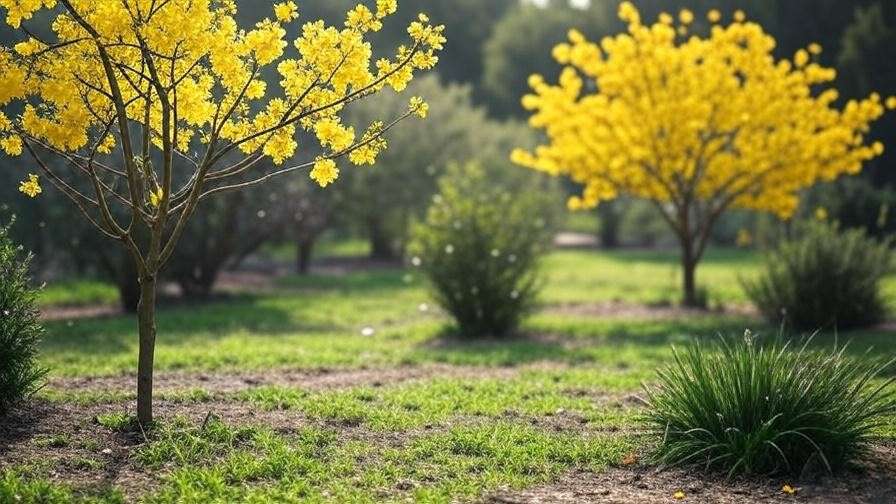Picture your garden aglow with golden blooms, buzzing with bees, and radiating warmth that stops neighbors in their tracks! Flowering trees with yellow flowers are nature’s way of adding joy, elegance, and eco-friendly charm to any outdoor space. Whether you’re a seasoned gardener or a beginner looking to elevate your landscape, these trees offer a perfect blend of beauty and function. In this comprehensive guide, we’ll explore the best flowering trees with yellow flowers, share expert planting and care tips, and inspire you to create a vibrant, pollinator-friendly garden that thrives year-round. 🌿
Yellow flowering trees do more than dazzle the eyes—they support local ecosystems, provide shade, and boost property value. Backed by insights from horticulturists and real-world gardening experience, this article will help you choose the perfect tree, plant it with confidence, and care for it like a pro. Let’s dive into the world of golden blooms and transform your garden into a sunny paradise! 🌸
Why Choose Flowering Trees with Yellow Flowers? 🌻
Aesthetic Appeal and Emotional Impact
Yellow is the color of sunshine, joy, and optimism, making flowering trees with yellow flowers a standout choice for any garden. Their vibrant blooms create a cheerful focal point, whether in a modern minimalist yard, a cozy cottage garden, or a lush tropical landscape. For example, a Golden Chain Tree’s cascading yellow blooms can turn a simple backyard into a breathtaking retreat. Pair these trees with contrasting colors like purple lavender or red roses for a visually stunning effect that elevates your garden’s design. 😊
Ecological Benefits
Beyond beauty, yellow flowering trees are ecological powerhouses. Their nectar-rich blooms attract pollinators like bees, butterflies, and hummingbirds, supporting biodiversity and healthy ecosystems. Native species, such as the Yellow Buckeye, provide food and habitat for local wildlife, making them a sustainable choice for eco-conscious gardeners. According to Dr. Emily Carter, a horticulturist with the Royal Horticultural Society, “Yellow flowering trees are vital for pollinators, offering nectar early in the season when other food sources are scarce.” 🐝
Practical Advantages
These trees aren’t just pretty—they’re practical, too. Many provide cooling shade, reducing energy costs by shielding your home from harsh sunlight. They can also increase property value by enhancing curb appeal. For busy gardeners, low-maintenance options like the Desert Cassia require minimal upkeep while delivering maximum impact. Whether you’re looking to save time or create a lasting investment, yellow flowering trees deliver on all fronts. 🌴
Top 5 Flowering Trees with Yellow Flowers for Your Garden 🌼
1. Golden Chain Tree (Laburnum × watereri) 🌟
Description: The Golden Chain Tree is a showstopper, with long, cascading clusters of bright yellow flowers that bloom in late spring. Its elegant, drooping blooms resemble golden rain, earning it a place in many ornamental gardens.
Growing Zones: USDA Zones 5–7.
Care Tips: Plant in full sun with well-drained soil. Water regularly during the first year to establish roots. Prune after flowering to maintain shape and encourage next year’s blooms. 🌞
Pros: Compact size (15–25 feet tall), perfect for small gardens; stunning visual impact.
Cons: Seeds are toxic, so exercise caution around pets and children. 🐶
Expert Tip: Pair with purple alliums or salvia for a striking color contrast. “The Golden Chain Tree is a favorite for its dramatic blooms, but proper pruning is key to maximizing its flowering potential,” says arborist Mark Thompson.
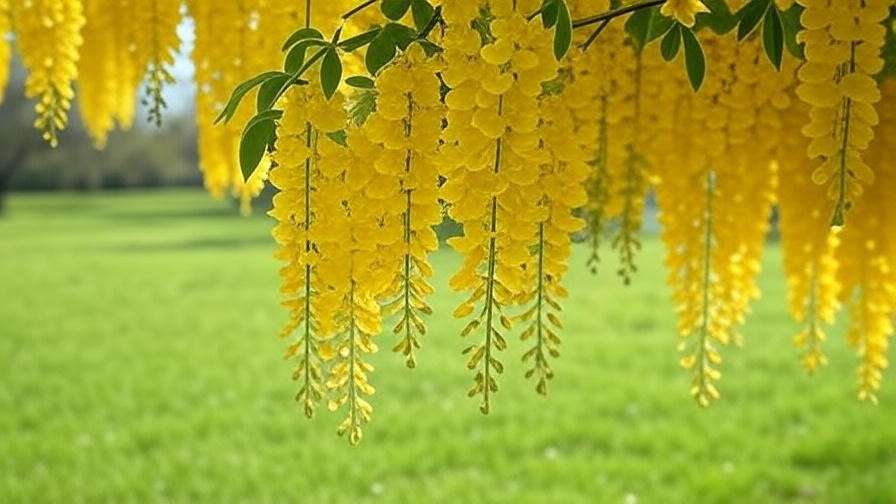
2. Yellow Buckeye (Aesculus flava) 🌳
Description: This native North American tree boasts upright spikes of yellow flowers in spring, followed by attractive foliage and buckeye nuts in fall. It’s a stately choice for larger landscapes.
Growing Zones: USDA Zones 4–8.
Care Tips: Thrives in moist, fertile soil and tolerates partial shade. Water deeply during dry spells and mulch to retain moisture. 🌦️
Pros: Supports wildlife; offers multi-season interest with flowers and fall color.
Cons: Requires ample space (40–60 feet tall); slow-growing.
Example: Ideal for parks or large backyards where its grandeur can shine.
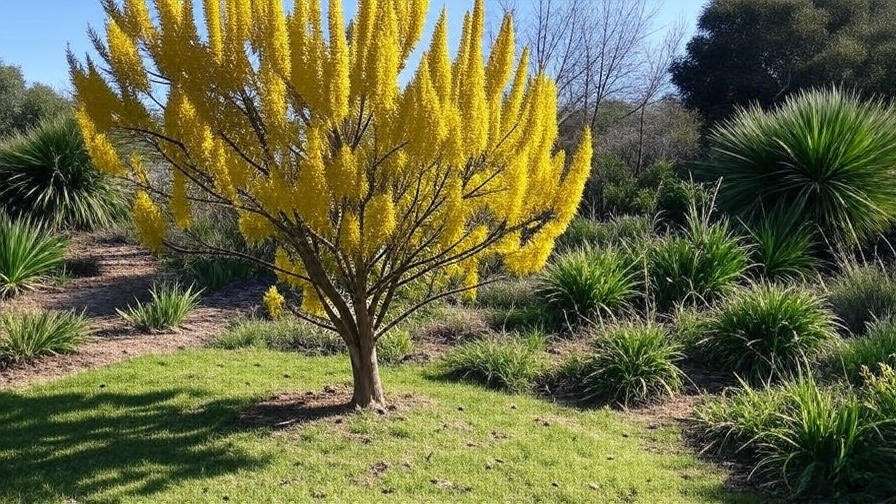
3. Tabebuia (Tabebuia spp.) 🌴
Description: Known as the “trumpet tree,” Tabebuia dazzles with vibrant, trumpet-shaped yellow flowers that bloom profusely in warm climates. It’s a staple in tropical and subtropical gardens.
Growing Zones: USDA Zones 9–11.
Care Tips: Plant in full sun with well-drained soil. Drought-tolerant once established, but water regularly during the first year. ☀️
Pros: Long bloom season; vibrant, tropical aesthetic.
Cons: Not cold-hardy; needs protection in cooler climates.
Expert Insight: “Tabebuia is a must-have for Florida and California gardens, where its golden blooms create a tropical oasis,” notes landscape designer Laura Hernandez.
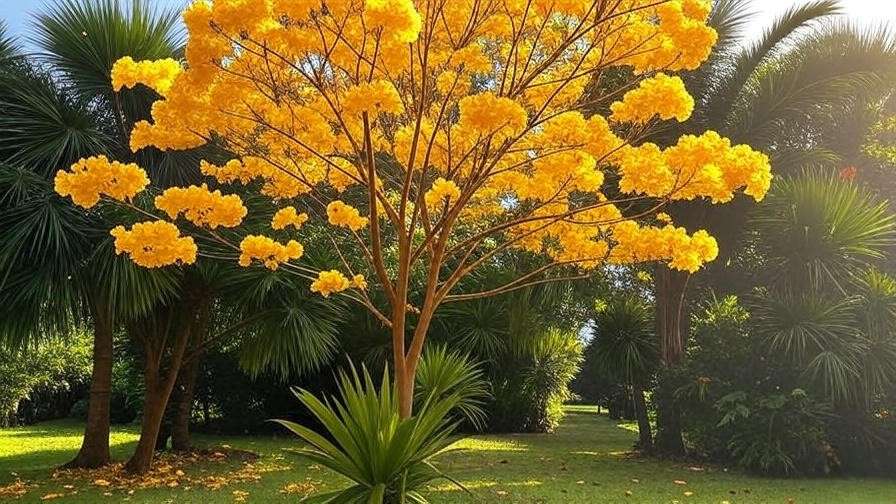
4. Cornelian Cherry (Cornus mas) 🍒
Description: This versatile tree or large shrub offers clusters of small, star-shaped yellow flowers in early spring, followed by edible red fruit and vibrant fall foliage.
Growing Zones: USDA Zones 4–8.
Care Tips: Adaptable to various soils; prefers full sun to partial shade. Low maintenance and drought-tolerant once established. 🌱
Pros: Multi-season interest; fruit can be used for jams or syrups.
Cons: Slow to establish; less dramatic blooms than other species.
Fun Fact: The fruit is a hidden gem for culinary gardeners—try it in homemade preserves! 🥄

5. Desert Cassia (Senna polyphylla) 🌵
Description: A small tree or shrub with delicate yellow flowers, Desert Cassia is perfect for arid landscapes. Its feathery foliage adds texture to xeriscaped gardens.
Growing Zones: USDA Zones 8–11.
Care Tips: Thrives in full sun and well-drained, sandy soil. Highly drought-tolerant; water sparingly. 🏜️
Pros: Ideal for low-water gardens; low maintenance.
Cons: Smaller blooms compared to other trees.
Example: A top pick for desert or Mediterranean-style landscapes.
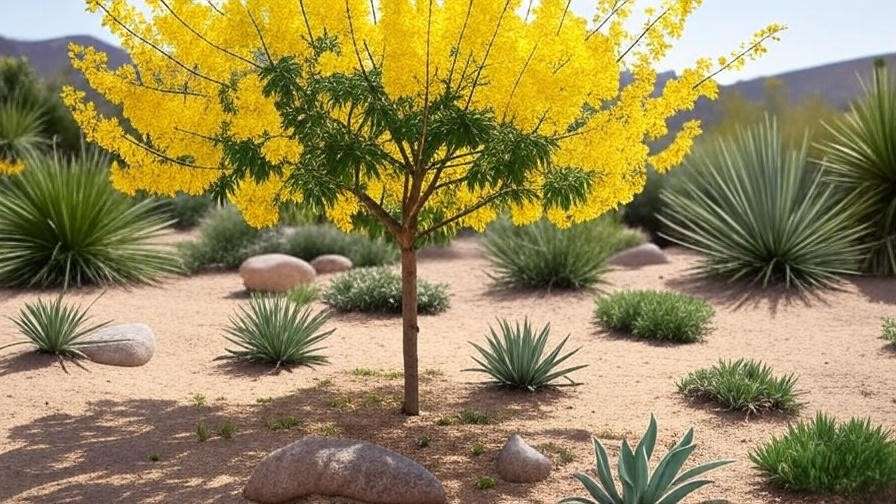
How to Choose the Right Yellow Flowering Tree for Your Garden 🌿
Assessing Your Climate and Growing Zone
Selecting a tree that thrives in your climate is critical. Check your USDA Hardiness Zone using the USDA Zone Finder (available online) to ensure compatibility. For example, Golden Chain Trees flourish in cooler zones (5–7), while Tabebuia thrives in warm zones (9–11). Matching your tree to your region prevents costly planting mistakes and ensures long-term success. 🗺️
Considering Space and Garden Size
Your garden’s size dictates your tree choice. Compact trees like Golden Chain or Desert Cassia suit small urban yards, while Yellow Buckeye needs room to spread in larger landscapes. Measure your planting area and consider mature tree size to avoid overcrowding. Expert Tip: “Always plan for the tree’s mature height and width to prevent future issues,” advises arborist Sarah Lin. 🏡
Soil and Sunlight Requirements
Yellow flowering trees have varying soil and sunlight needs. Most, like Tabebuia, prefer full sun (6+ hours daily) and well-drained soil. Test your soil’s pH and drainage at home using a simple kit from your local nursery. For clay-heavy soils, amend with compost to improve drainage. Desert Cassia, for instance, thrives in sandy soils, while Yellow Buckeye prefers fertile, loamy conditions. 🌍
Maintenance and Time Commitment
Consider your gardening schedule. Low-maintenance trees like Cornelian Cherry or Desert Cassia are ideal for busy homeowners, requiring minimal pruning or watering. Golden Chain Trees, however, demand regular pruning to maintain their shape and health. Choose a tree that aligns with your time and effort availability. ⏳
Planting and Caring for Your Yellow Flowering Tree 🌱
Planting Tips for Success
The best time to plant yellow flowering trees is in spring or fall, when cooler temperatures promote root growth. Follow these steps for success:
- Dig the Hole: Make it twice as wide and as deep as the root ball. 🕳️
- Prepare the Soil: Mix native soil with compost for nutrient-rich planting.
- Position the Tree: Place the root ball level with the ground and backfill gently.
- Water Thoroughly: Soak the soil to eliminate air pockets.
Expert Insight: “Avoid planting too deep, as this stresses the tree and can lead to rot,” warns certified arborist John Davis.
Watering and Fertilizing
Young trees need consistent watering—about 1–2 inches per week for the first year. Mature trees, like Desert Cassia, are drought-tolerant and require less frequent watering. Use organic fertilizers, such as compost or fish emulsion, in early spring to boost growth. Mulch around the base with wood chips to retain moisture and suppress weeds. 🌾
Pruning and Maintenance
Pruning enhances flowering and maintains tree health. For Golden Chain Trees, prune after blooming to shape the canopy and remove dead wood. Avoid over-pruning, which can reduce next year’s flowers. Use clean, sharp tools to prevent disease. Example: Pruning Tabebuia in late winter encourages vibrant spring blooms. ✂️
Pest and Disease Management
Common pests include aphids, scale, and caterpillars, which can be managed with neem oil or insecticidal soap. Watch for diseases like powdery mildew or root rot, especially in poorly drained soils. Prevent issues by ensuring proper spacing, watering, and soil health. Companion planting with marigolds can deter pests naturally. 🐛
Design Ideas: Incorporating Yellow Flowering Trees in Your Landscape 🎨
Creating Focal Points
A single yellow flowering tree can transform your garden into a stunning centerpiece. For instance, a Tabebuia with its vibrant golden blooms can anchor a front yard, drawing eyes from the street and boosting curb appeal. Place the tree in a prominent location, such as near a patio or entrance, to maximize its impact. Surround it with low-growing plants to highlight its stature without competing for attention. A Golden Chain Tree, with its cascading blooms, works beautifully as a focal point in smaller gardens, creating a dramatic effect in limited space. 🌳
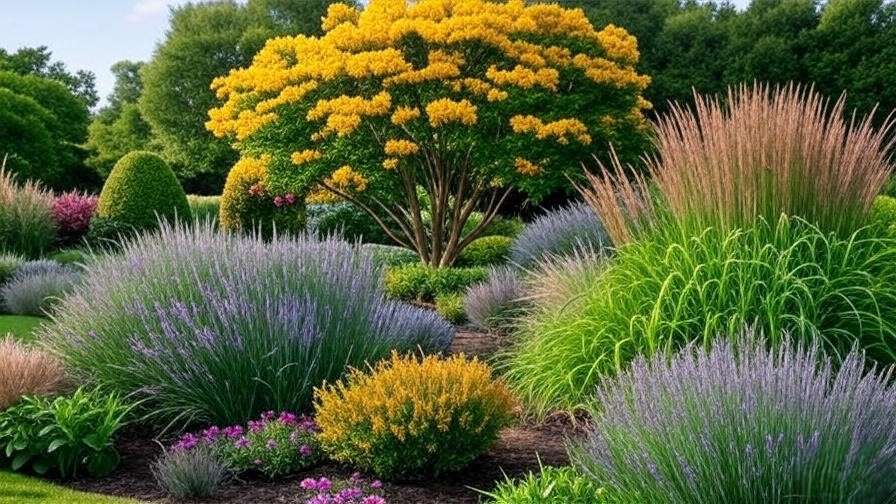
Companion Planting
Pairing yellow flowering trees with complementary plants enhances your garden’s beauty and harmony. For example, combine a Cornelian Cherry with purple-flowering perennials like lavender or salvia for a striking color contrast. Ornamental grasses, such as fountain grass, add texture and movement around a Desert Cassia. Expert Tip: “Use color theory to balance warm yellow blooms with cool-toned plants like blue catmint for a cohesive design,” suggests landscape designer Emma Rodriguez. Companion plants also support pollinators, creating a thriving ecosystem. 🌼
Seasonal Interest
Yellow flowering trees can anchor a garden with year-round appeal when paired strategically. For instance, the Cornelian Cherry offers spring blooms, summer fruit, and vibrant fall foliage, making it a multi-season star. Pair it with evergreens like boxwood or junipers to maintain structure in winter. Alternatively, a Yellow Buckeye’s golden flowers in spring and rich autumn leaves create a dynamic display. Plan for overlapping bloom times with other plants, such as late-summer blooming crape myrtles, to ensure continuous color. 🍂
Common Mistakes to Avoid When Growing Yellow Flowering Trees 🚫
Growing yellow flowering trees is rewarding, but simple mistakes can hinder their success. Overwatering is a common issue, especially for species like Desert Cassia, which thrives in dry conditions. Ensure proper drainage to prevent root rot, particularly in clay-heavy soils. Planting in the wrong USDA zone can doom a tree—Golden Chain Trees won’t survive in tropical zones, while Tabebuia struggles in cold climates. Neglecting pruning can also reduce blooms or lead to weak growth; for example, skipping post-bloom pruning on a Golden Chain Tree limits next year’s flowers. Finally, ignoring pests like aphids can escalate into infestations. Case Study: A homeowner in Zone 6 planted a Tabebuia without frost protection, resulting in tree loss. Always research your tree’s needs and monitor its health regularly. 🐞
FAQs About Flowering Trees with Yellow Flowers ❓
Q1: Which yellow flowering trees are best for small gardens?
A: Compact trees like the Golden Chain Tree (15–25 feet) and Desert Cassia (10–15 feet) are ideal for small spaces. They offer vibrant blooms without overwhelming your yard. 🌿
Q2: Are yellow flowering trees safe for pets?
A: Most are safe, but Golden Chain Tree seeds are toxic to pets and children. Opt for pet-friendly options like Cornelian Cherry or consult a veterinarian for guidance. 🐕
Q3: How long do yellow flowering trees bloom?
A: Bloom times vary—Golden Chain Trees bloom for 2–3 weeks in spring, while Tabebuia can flower for months in warm climates. Proper care extends bloom duration. 🌸
Q4: Can I grow yellow flowering trees in containers?
A: Yes, smaller species like Desert Cassia can thrive in large containers with well-drained soil. Ensure adequate sunlight and water sparingly. 🪴
Q5: What are the most pollinator-friendly yellow flowering trees?
A: Yellow Buckeye and Cornelian Cherry are top choices, attracting bees and butterflies with nectar-rich blooms. Plant near other pollinator-friendly plants for maximum impact. 🐝
Conclusion: Brighten Your Garden with Yellow Flowering Trees 🌞
Flowering trees with yellow flowers are a game-changer for any garden, offering unmatched beauty, ecological benefits, and practical advantages. From the cascading blooms of the Golden Chain Tree to the tropical flair of Tabebuia, these trees bring joy, shade, and pollinator support to your outdoor space. By choosing the right tree for your climate, planting with care, and following expert maintenance tips, you can create a vibrant, sustainable landscape that shines year-round. Start planning today—visit your local nursery, consult an arborist, or share your garden transformation on social media to inspire others! 🌳
Call to Action: Pick one of these stunning yellow flowering trees, plant it with confidence, and watch your garden come alive. Share your results with us using #YellowBloomGarden for a chance to be featured! 📸

